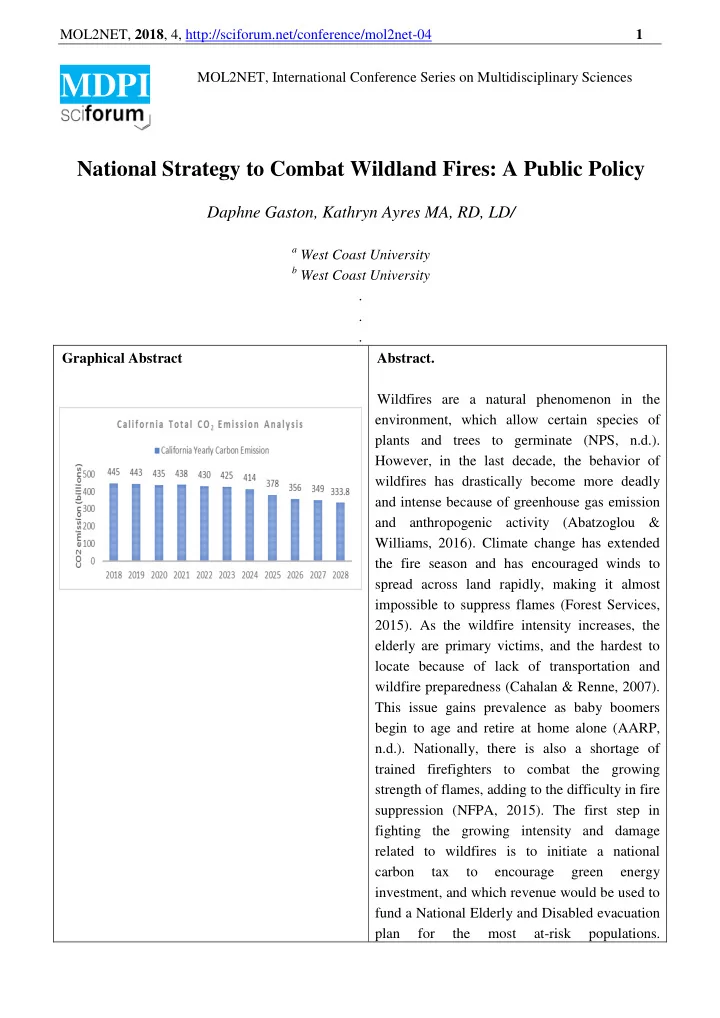

MOL2NET, 2018 , 4, http://sciforum.net/conference/mol2net-04 1 MOL2NET, International Conference Series on Multidisciplinary Sciences MDPI National Strategy to Combat Wildland Fires: A Public Policy Daphne Gaston, Kathryn Ayres MA, RD, LD/ a West Coast University b West Coast University . . . Graphical Abstract Abstract. Wildfires are a natural phenomenon in the environment, which allow certain species of plants and trees to germinate (NPS, n.d.). However, in the last decade, the behavior of wildfires has drastically become more deadly and intense because of greenhouse gas emission and anthropogenic activity (Abatzoglou & Williams, 2016). Climate change has extended the fire season and has encouraged winds to spread across land rapidly, making it almost impossible to suppress flames (Forest Services, 2015). As the wildfire intensity increases, the elderly are primary victims, and the hardest to locate because of lack of transportation and wildfire preparedness (Cahalan & Renne, 2007). This issue gains prevalence as baby boomers begin to age and retire at home alone (AARP, n.d.). Nationally, there is also a shortage of trained firefighters to combat the growing strength of flames, adding to the difficulty in fire suppression (NFPA, 2015). The first step in fighting the growing intensity and damage related to wildfires is to initiate a national carbon tax to encourage green energy investment, and which revenue would be used to fund a National Elderly and Disabled evacuation plan for the most at-risk populations.
MOL2NET, 2018 , 4, http://sciforum.net/conference/mol2net-04 2 Additionally, allowing an inmate rehabilitation program will provide an employment of an additional 8,000 non-violent inmate firefighters, which will drastically help the national firefighter shortage, while also reducing recidivism. As the United States prepares to exit from the Paris Agreement, it is imperative that states, and Congress take initiative to regulate the scaling contributions of fossil fuel emission in order to control the rising danger of wildland forest fires. Introduction Tree scars show that wildfires have been ravishing through forests for hundreds of years, and are crucial for stability of certain ecosystems. For example, up to 33 natural plants of the Everglades National Park depend on fire for their long-term survival, and in California the ceanothus, a plant with leaves coated in flammable resin, also depends on heat to sprout (NPS, n.d.). In a measured setting, a prescribed fire or planned fire, can manage potential fuel hazards, while allowing these plants to germinate (NPS, n.d.). Prescribed fires permit firefighters and forest rangers to manage the intensity of a future wildfire and create a balanced environment between ecosystems that require heat to survive. During the wildfire season, these leaves and other parts of the plant act as a source of energy for the fire, and can create the perfect scenario for an uncontrollable, extreme wildfire. As many as 90% of wildland fires in the United States are caused by human activity including, burning of debris, negligent discard of flammable material, or arson (NPS, n.d.). The remaining 10% can be attributed to natural occurrences such as lightning strikes and controlled fires (NPS, n.d., para. 5). Occurrence of wildfires in the past few decades have decreased, but damage and acreage impacted by the intensity of the fires has grown (Urban Institute, 2016, pg. 4). Incidence control can be attributed to education on fire safety and management strategies that have been in practice over the past few years. However, changes in the climate have altered the length of fire season, frequency of fires, and intensity of flames by means of high temperatures and droughts (EPA, n.d., para.1). The change in behavior of wildfires requires an updated and efficient policy change to fire management, evacuation plans, and fire team strategies to combat the rise in suppression costs, structural damage, and injuries sustained during extreme fires. On October 8, 2017, a wildland fire began in California and would become one of the most damaging and deadliest wildfires in US history (Park, 2017). The fires burned more than 220,000 acres through California’s Sonoma and Napa counties leaving over 5,000 structures destroyed, and 36 people dead (Park, 2017). Primary victims of this tragedy included the elderly and disabled. Survivors of the fire described being caught off guard by how quickly the flames spread through their area, leaving them with little time to evacuate. The smoke from the intensity of the fires spread throughout San Francisco and hazardous particle matter was detected in southern states such as Texas and Oklahoma (Airnow, 2017). Effects of the wildfire lasted for weeks, while the emotional, structural, and financial damage will last for years. The National Weather Service provides fire conditions to compromised zones over a 12-72- hour period (FEMA, 2014). Some areas estimate fire danger and need for evacuation by standard of The National Fire Danger Rating System, with levels starting at low, ranging to moderate, high, very high, and extreme (USDA, n.d.). It is encouraged for families to have communicated plans for evacuation, with valuables, important documents, and prescriptions ready in case of the need to leave (FEMA, 2014, pg.7) Hospitals are also required to have an evacuation plan for admitted patients, including transfers to other hospitals or relocation to a safe shelter (CHA, n.d.) Training for medical
Recommend
More recommend